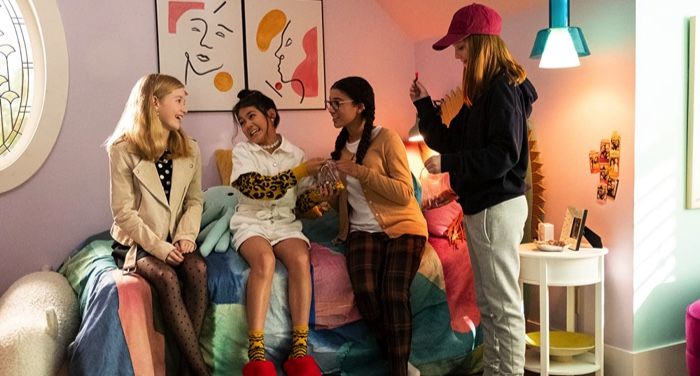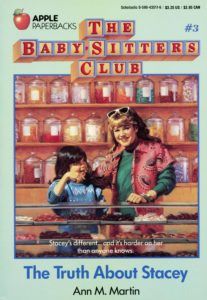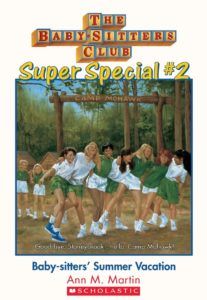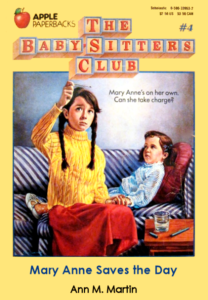
Why THE BABY-SITTERS CLUB Netflix Series is Even Better Than the Books
Have you watched the new The Baby-Sitters Club Netflix series yet? If you were a ’90s bookish kid like me, there are fewer things more nostalgic than The Baby-Sitters Club. HUGE BSC fan over here. I owned over a hundred of the books (including super specials and mysteries), plus that chain letter one that had actual physical letters and postcards to and from the BSC members. Dreaming of being sophisticated and resilient like Stacey, I was actually more Mallory. (She was the nerdy oldest child of a bunch of siblings and obsessed with reading and writing). I had a crush on the sporty, bossy Kristy.
So of course I was so excited to hear about the new Netflix show! I had high hopes, but I tried to temper them. After all, I am keenly aware, as an adult, of the books’ faults. And I wasn’t sure how well the books would translate to 2020 as they kept the core concepts but modernized. I am so happy to say after blazing through the entire first season, that I think Netflix The Baby-Sitters Club series is even better than the original books. Here are four reasons why:
1) Issues Aren’t Presented Didactically
As much as I loved them, a little too often the original BSC books felt very much like capital-i “Issue Books.” Like, “this is the one where we address the racism inherent in Thanksgiving celebrations,” or, “This is the one about teenage drinking,” or, “This is the one where we teach you about internment camps for Japanese Americans.” And so on and so on. These kinds of books could easily translate to cheesy “Very Special Episodes.” It’s not that the take on these themes is problematic. (In fact, usually it appears the creator is trying very hard to prove a progressive point). But there’s a sense that the writers are forcing the story to present a certain thesis, rather than the story itself coming first.

2) The Inclusion of Girls of Color Beyond Tokenism
The original BSC members were mostly white with two girls of color characters. It seemed a given that we’d never get more than one character of any non-white racial background, even though there were many different white girls. I don’t want to diminish the importance of Claudia Kishi for Asian American (and Canadian, etc.) girls and Jessi Ramsey for Black girls. But looking back, it’s hard not to see them as at least partial tokens. They made the BSC appear racially diverse and inclusive while still being majority white. (There was also the late addition of Abby Stevenson, a Jewish character who similarly felt like Ann M. Martin had added her specifically for non-Christian representation).
The new Netflix series has made a few significant changes. Mary Anne, who was a white girl with brown hair in the books, is now a biracial Black girl with a white dad. Dawn, originally a blonde California girl, is now a Latina California girl. This now makes the BSC majority girls of color! These changes are simply thrilling and absolutely the right move.
Particularly with Mary Anne, her being Black really works well with modernizing her character’s original narratives. In the context of the US’s anti-Blackness, Mary Anne’s dad’s overprotectiveness and worry make a lot of sense. His not knowing how to do her hair except for in braids makes a lot of sense too! (Mary Anne’s Black mom having died without being able to pass on skills to either Mary Anne or Richard). And shout-out to the renaming of what was originally called “Camp Mohawk” to Camp Moosehead.
3) It’s Self-Aware as Nostalgia
No one remembers the original BSC books as self-aware or self-referential by any means. The Netflix series is certainly no bastion of metanarrative. (It wouldn’t fit the tone of the show at all if it were.) But there are some sly references that show the writers are aware of The Baby-Sitters Club as nostalgia and important cultural touchstone. When Claudia comes up with the logo for the club, the retro drawing she sends Kristy is the original one. Other little tidbits refer to the ’90s like when Kristy says that Dawn is “alternative in a ’90s kind of way.”

There’s also the fact that by casting Alicia Silverstone as Kristy’s mom, the series sends a clear nod to its ’90s kids audience. There’s no way to read Kristy’s voiceover in the first episode saying “when it came to life, I guess [my mom] wasn’t totally clueless” as anything other than a reference to Silverstone’s iconic role in the 1995 movie Clueless. (Clueless itself being another TV/film adaptation of a beloved classic — Emma by Jane Austen — that excellently translated to a contemporary context). Check out one of Claudia’s very Cher Horowitz outfits too.
4) Inclusion of Queer and Trans Characters
It would have meant the world to me if there had been LGBTQ+ representation in the BSC books. But it’s hard to imagine that Ann M. Martin would have been allowed to continue writing the series in the ’80s and ’90s if she had included queer or trans characters. This is a particularly thorny issue as Martin wasn’t out herself at the time. Writing LGBTQ+ characters might have outed her. Annie on My Mind, the first queer YA novel to have a happy ending, was published in 1982. It has a long history of being challenged and banned. That was the kind of atmosphere in which the BSC books were first published. All this to say I find it hard to fault Martin for not writing any explicit queer or trans characters. But it is sad that she didn’t!
In The Baby-Sitters Club on Netflix, however, there is a decent amount of LGBTQ+ representation. Dawn’s parents are divorced (as in the original story). But in the reboot her dad is gay and in a relationship with another man. We get to see them briefly as Dawn FaceTimes with them. One of the teachers at Stoneybrook Middle School is in a lesbian relationship. We meet her and her wife, whose kid is Charlotte Johanssen, AKA Stacey’s favorite babysitting charge, multiple times. One of the boys Mary Anne meets in Boy Crazy Stacey casually mentions he had a crush on a boy at theater camp. Stacey even namedrops Queer Eye at one point!

In the Netflix series, however, Bailey is trans. At the hospital, two hospital staff misgender Bailey. (They are looking at an old medical chart.) Mary Anne takes the opportunity to take the adults aside. She firmly and compassionately advocates for Bailey. The scene is incredibly moving (I’m crying again just thinking about it!). It’s moving both in terms of seeing a trans kid’s rights asserted and Mary Anne’s growth as a young person learning to be assertive.
Do I wish one of the core BSC members was LGBTQ+? Absolutely! And I think there’s potential established for Kristy in particular. She rocks her tomboy “normcore” look. She confidently asserts that she’d “rather have head lice (again!) than go to a school dance.” But I guess I will just have to see in season 2, waiting with my fingers crossed.
Okay, fellow ’90s bookish kids! What did you think of The Baby-Sitters Club Netflix series? Do you concur that it’s even better than the original books? Why or why not?













